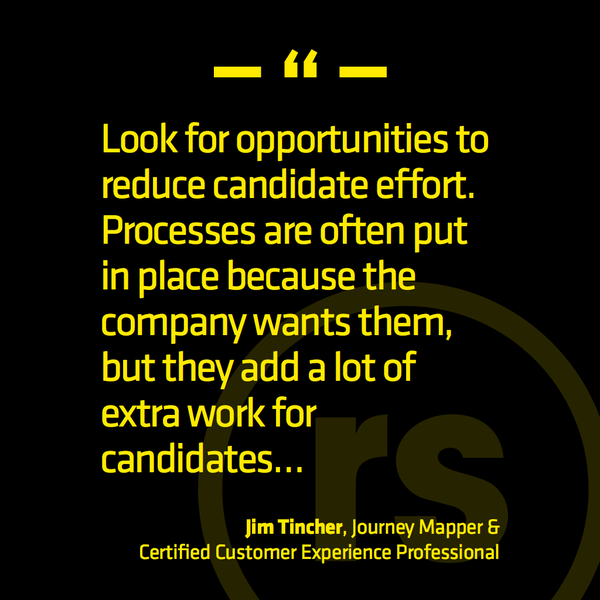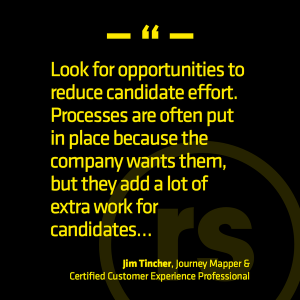
 Here’s a Q&A I did recently with Recruiting Social, who asked me to talk about using CX in the hiring process to improve candidate experience.
Here’s a Q&A I did recently with Recruiting Social, who asked me to talk about using CX in the hiring process to improve candidate experience.
If the goal is to get the best talent, yet you make people go through really hard and opaque application and recruitment processes, you’re automatically removing potential candidates. You don’t know who they are. You don’t know if you are chasing away the people who are just not interested, or if you’re chasing away the best talent.
Is the applicant willing to reformat their resume so it’s easier for you to use and search? Maybe resumes disappear into a black box and applicants never hear anything back and never get any feedback. Does a potential applicant want to go through an experience like that? It’s very easy to get into the mindset that, “If this candidate doesn’t like a process, we’ll find another candidate.” I’ve actually heard from recruiters in the past that were getting too many job applications, so they deliberately decided to not make the process easy, so they could weed out some of the applicants. Well, doing that you’re probably weeding out the wrong ones.
Not caring about the experience degrades the quality of candidates, because they know that you are not serious about hiring the best talent.
Your company’s probably not rejecting a lot of customers, but you are rejecting a lot of candidates. How you do that is incredibly important because you want to be rejecting them for today, not rejecting them permanently. They just may not be a fit for this role right now. But many organizations don’t think about that. They don’t provide feedback for why the candidate is not a fit, which would allow them to then think about roles where they may be a better fit.
On the customer experience side, when someone gives us feedback, we absolutely have to make sure to follow up – it’s called a ‘closed loop process’. Every interaction with a customer requires a response. You have to ask yourself and your company, “How are we reacting to that, and why?” Well, applying for a job is the ultimate form of feedback on the candidate’s side. If we want them to apply for other roles in the future, we need to give feedback for why they’re not selected. Many organizations are so compliance-driven that they don’t give that feedback or they give that generic letter that goes: “We were very impressed by your skills, however, there is another candidate who is a better match.” We’ve all read that letter. But what the thinking needs to be, is: “If my goal is to find the best candidate today but to keep somebody here as a possibility for the future, how can I give them feedback that makes them want to apply for a future role where they’re a better fit?”
It’s important to think about. You can put together a workshop of recent hires to map out what it was like as a job candidate. The first thirty days on the job is a key time, while it’s still fresh in their minds. I did this recently for a nearby city government.
I’m not familiar with what Airbnb did with their team. I can tell you that what you do want to avoid – this the biggest battle I fight – is the thinking that you can put a bunch of internal people in a room, get them to fill out some post-it notes, and bam! You’ve got a journey map.
Is this is what the candidates go through? No, this is what you think the candidates go through, which is distinct from their true experience. We have our clients build a journey map at the beginning of our research. We have the teams map out what they think we’re going to find. It’s always different from what real customers say. Significantly different. If you just bring your recruiting folks into the room and map out your candidate experience, I guarantee you’re wrong. I’ll put any kind of money on the table. You’re missing the real moments of truth because you are looking at it as somebody who:
You don’t have the anxiety that a job seeker goes through. If someone is looking at taking on this new role and they’re unemployed, they’re certainly anxious. But even if they are employed, it’s a big move to go to another company. There’s anxiety there. And odds are, you aren’t factoring it into your processes. Most companies aren’t doing it on the customer side – what are the odds that they’re doing it for candidates?
I think that is a separate process. But you would want to map out what the hiring manager experience is like and how easy is it for them to work with you. I have not found a lot of human resources departments interested in making it easy for their internal business customers. That’s something to think about.
One of the places to start looking is effort; look for opportunities to reduce candidate effort. Processes are often put in place because the company wants them, but those processes add a lot of extra work for the customers, or in this case candidates – effort that nobody ever thinks about.
Certainly. But it takes a certain kind of person to do that, because you, as a part of the HR or recruiting team, know why every step and question is there. Can you really put on the beginner’s mind-set? Some can, but most can’t.
For example, we often find it easier to require a customer or candidate to provide all the information we need up front so we don’t have to chase that information later on. Maybe you’re asking for all kinds of security clearances in the initial job application. Well, you aren’t going to need that information for ninety-eight per cent of those applicants, are you? It’s only those who get to the last stage of the recruiting process for whom that becomes relevant. But when a potential applicant sees they need to go through fives screens of providing all this information just to apply for a job, you may have lost them right there.
HR should be getting serious about customer experience, because the biggest chunk of customer experience is made up by employees. That’s not just the obvious roles, like customer service or associates in a retail environment. It’s also the back end roles: marketing, finance, product design. Most of these people have never met a customer, and have no interest in it, and because of that have a hard time understanding what a customer wants. We focus on hiring experts, but it takes someone who is inquisitive and thinks very much from the outsider’s perspective to produce products and services that people want to buy.
It’s funny, HR is almost never involved with the customer experience – they almost never have a seat at the table – and yet it’s so much harder to create the culture change needed for a game-changing customer experience without them.
That’s the first thing. The second thing is you can use that same kind of customer experience thinking and apply it internally. A number of organizations have people who think about how to streamline customer processes. There is no reason not to apply that for the employee or candidate experience. A good way to initiate that conversation is if you’re doing an employee engagement survey – customer experience is usually very interested in that. Reach out to that person, and work with them to start applying their expertise internally.

